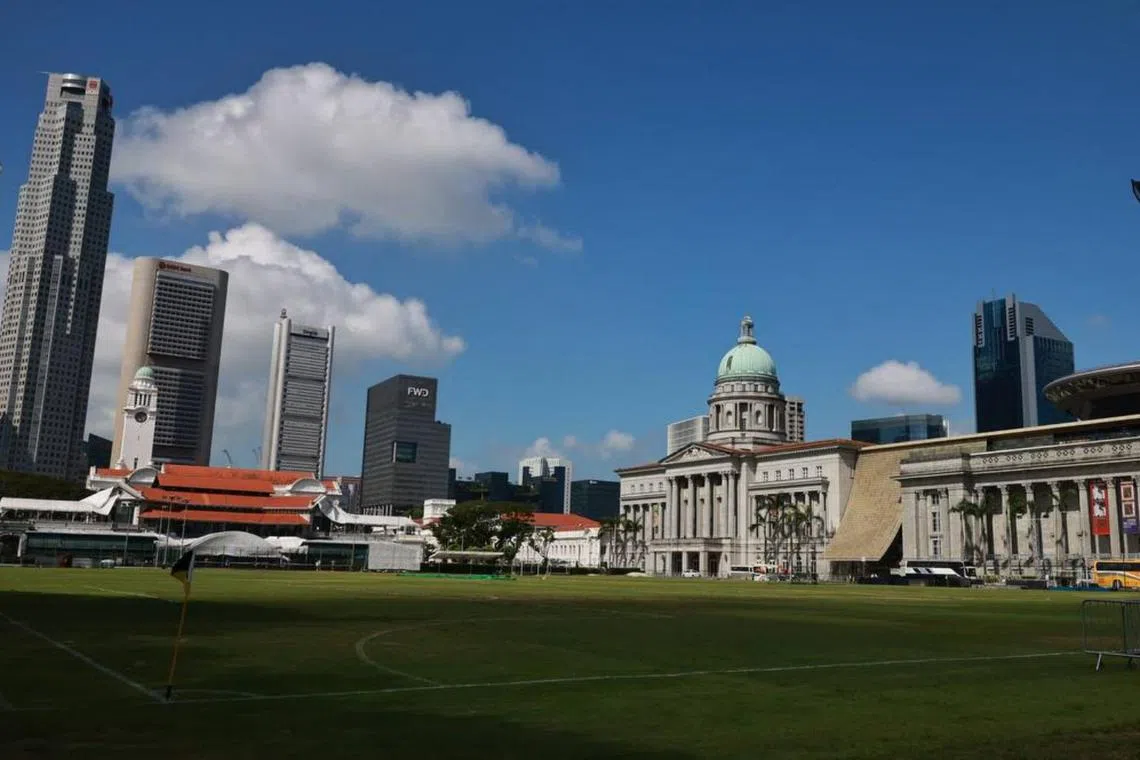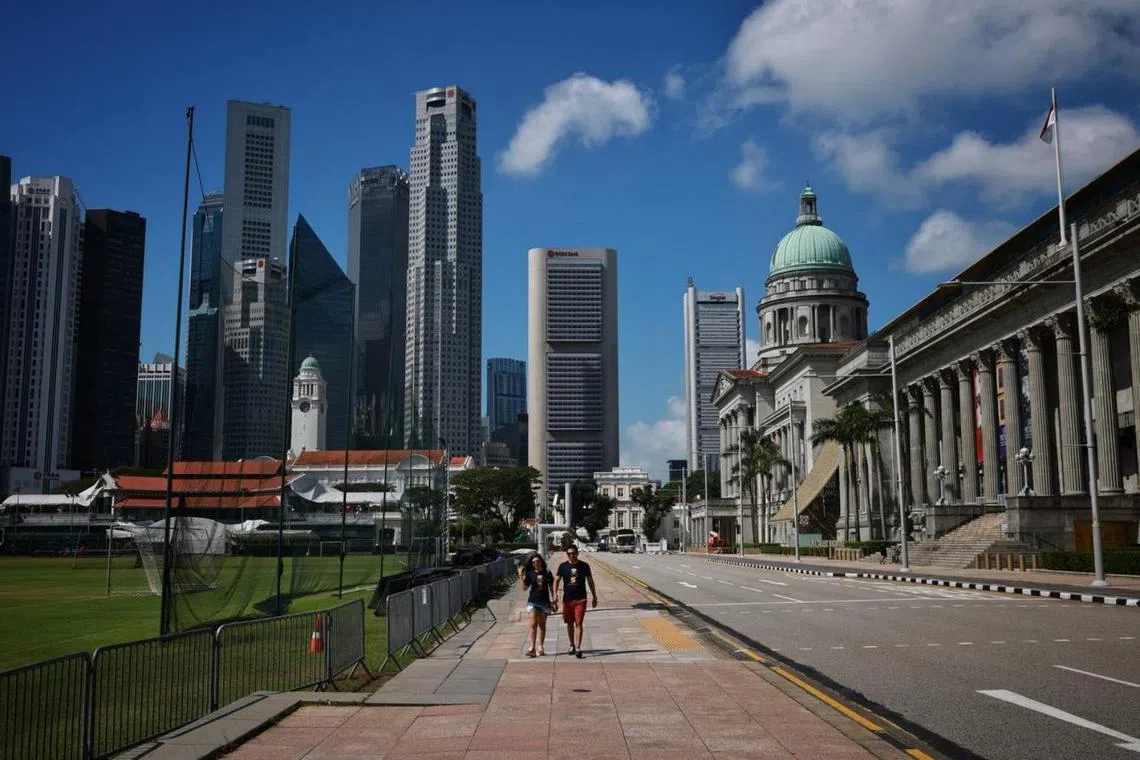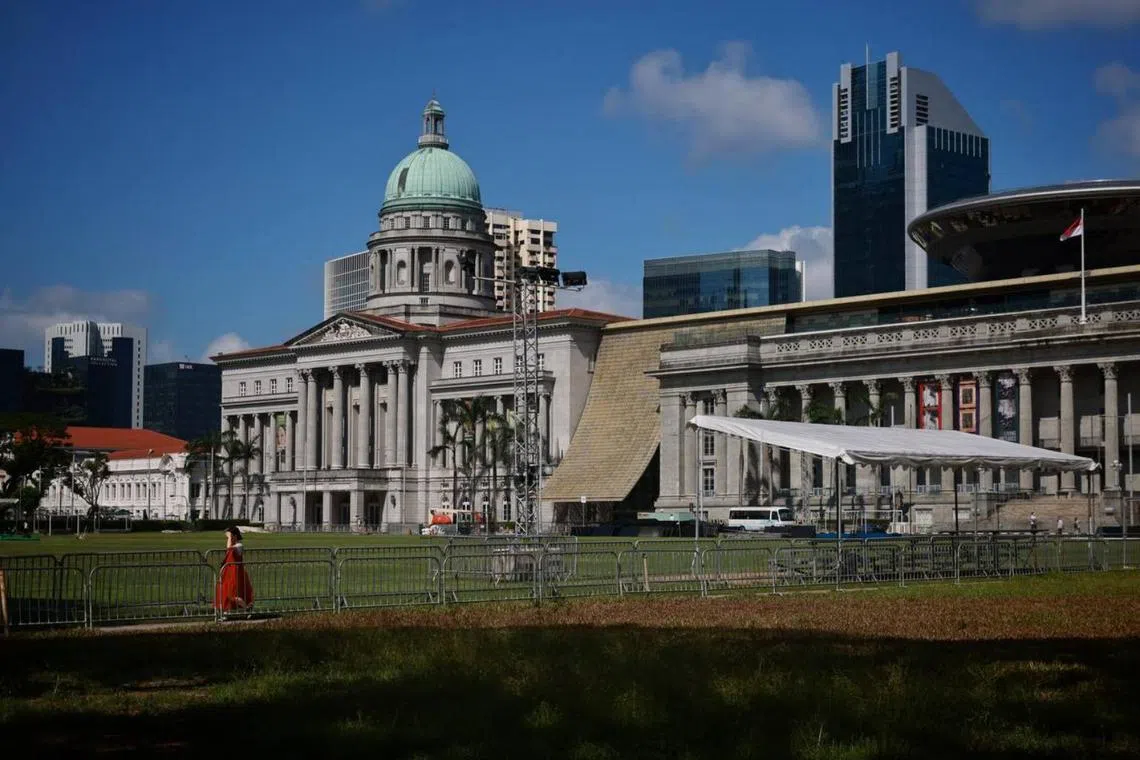Padang, surrounding buildings potential candidate for Singapore’s 2nd Unesco World Heritage Site
Sign up now: Get ST's newsletters delivered to your inbox

The Padang, sited in the heart of Singapore’s civic district, was gazetted as Singapore’s 75th national monument on Aug 9, 2022.
ST PHOTO: JASON QUAH
Follow topic:
SINGAPORE – The Padang Civic Ensemble – comprising the historical green, open space
The National Heritage Board (NHB) on Thursday said the ensemble is most likely to fulfil one of 10 criteria for World Heritage Sites, as an “outstanding example of a type of building, architectural or technological ensemble or landscape” that illustrates a significant stage, or stages, in human history.
The Padang Civic Ensemble is “an outstanding example of a British colonial civic square in the tropics”, NHB said in a statement.
“The coalescence of colonial-era and post-independence civic institutions within a single municipal area bears testament to the historically widespread phenomenon of decolonisation, and the globally significant transition of long-held British territories to newly independent nations in the decades following World War II,” the statement added.
Besides its high potential to meet Unesco’s criteria, the Padang Civic Ensemble also has national and historical significance, NHB said.
The Padang, sited in the heart of Singapore’s civic district, was on Aug 9, 2022, gazetted as Singapore’s 75th national monument
NHB noted that adjacent buildings such as the former Supreme Court and City Hall which now form the National Gallery, Victoria Theatre and Concert Hall, Old Parliament House and St Andrew’s Cathedral similarly have high historical significance.
A successful nomination will provide greater recognition of Singapore’s heritage on the world stage, raise awareness of heritage preservation here, foster a sense of national identity and pride, and ensure the site is preserved for future generations, the board said.
Unesco World Heritage Sites are cultural or natural sites considered to be of outstanding universal value. Unesco is a United Nations body that promotes international cooperation on education, science and culture.

The Padang (left) and National Gallery Singapore (right) on March 9, 2023.
ST PHOTO: JASON QUAH
These sites must fulfil at least one of 10 criteria laid out in the World Heritage Convention, such as bearing a unique testimony to a cultural tradition or civilisation which is living or has disappeared, or representing “a masterpiece of human creative genius”. Singapore ratified the convention in June 2012.
According to the NHB’s Roots.gov.sg heritage resource portal, the Padang is among Singapore’s oldest open spaces for public recreation. It is also a commemorative space for people to gather, and witness and participate in key milestones of the nation’s history.
During the colonial period, the space was used for official celebrations and festivities, such as royal birthdays and coronations. On Sept 12, 1945, it was the venue for a victory parade that marked the end of the Japanese Occupation in Singapore.
The Padang also hosted many of Singapore’s National Day celebrations, including in the years from 1961 to 1963 when the state was self-governed as part of the British Empire, and in 2015, the golden jubilee of Singapore’s independence.
It has been a mainstay in Singapore’s urban and social fabric since the colonial era, said NHB, adding that the space was the focal point of a British colonial civic square that the post-independence government subsequently used.
The extent of the site that will be included in the planned nomination is still being studied.

Buildings adjacent to the Padang, like the National Gallery, pictured on March 9, 2023, similarly have high historical significance.
ST PHOTO: JASON QUAH
NHB said it will take part in a preliminary assessment (PA) in September 2023 – a new mechanism in the World Heritage Site nomination process that allows states to receive guidance from the World Heritage Centre and advisory bodies such as the International Council on Monuments and Sites before the submission of an official nomination.
The board will also conduct further research in 2023 to assess the benefits and implications of the proposed nomination, and the exact timeline needed for a full-scale nomination, it added.
“The outcome of NHB’s research, as well as the results of the PA, will help guide the decision to be made at a later stage on whether Singapore will formally pursue the nomination,” the board said.
“This is an important step as Singapore will have to carefully study and balance long-term urban redevelopment needs with the protection requirements of a World Heritage Site.”
Ms Jean Wee, director of NHB’s preservation of sites and monuments division, said the board will work with land agencies in considering Singapore’s future urban redevelopment needs.
“Once we have fully undertaken our research, we will work closely with them to see how we can work these issues out to put up a credible nomination,” she added.

The Victoria Theatre and Concert Hall adjacent to the Padang pictured on March 9, 2023.
ST PHOTO: RYAN CHIONG
Asked if Singapore’s plan to nominate an assemblage of colonial era buildings could be seen as glorifying colonialism, Ms Wee said: “We can’t change the fact that historically, we were a British colony.
“But it is also important to recognise that it is from that point that we transitioned as a colony to a sovereign state. So, I think we need to be quite upfront in recognising that that is our history, and let’s raise an awareness of the full timeline of (Singapore’s) wealth of history as well.”
Architectural and urban historian Lai Chee Kien said NHB’s current framing of its potential bid remains primarily colonial in nature, and suggested that it add the Marina Bay area, including the rectangular water body surrounded by modern buildings such as Marina Bay Sands and Esplanade – Theatres on the Bay, to the nomination.
Noting that the areas are parallel to each other, and a stone’s throw apart, Dr Lai said when juxtaposed, the original Padang, a flat piece of land, and Marina Bay, a flat piece of water, showcase Singapore’s transition to post-independence and the country’s achievements since then.
“Both were made for spectating, the Padang to gaze upon buildings representing colonial power, and Marina Bay as an open space demonstrating Singapore’s progress in areas such as the economy and the arts,” he said.
Dr Lai added that including Marina Bay in a bid could help Singapore differentiate the Padang from other open fields that the British established in the region as part of colonial town planning, such as in Penang and Kuala Lumpur.
Associate Professor Johannes Widodo, the director of graduate programmes in architectural conservation at the National University of Singapore, said the various historical buildings around the Padang collectively add to the site’s significance, and allow it to also fulfil other criteria in Unesco’s convention.
He said that based on Singapore’s 14th-century history, when it served as the nexus of a South-east Asian maritime network linking the Indian and Pacific oceans, the Padang area – understood to be the centre for society then – could fulfil criterion (ii) requiring sites to “exhibit an important interchange of human values, over a span of time or within a cultural area of the world, on developments in architecture or technology, monumental arts, town-planning or landscape design”.
Furthermore, said Dr Widodo, the Padang and its surrounds have been a meeting place for various cultures through trades, and have served multiple other social and state functions, which fulfils criterion (vi) requiring sites to be “directly or tangibly associated with events and living traditions”.
The Padang Civic Ensemble’s planned nomination as Singapore’s second World Heritage Site follows the inscription of the Singapore Botanic Gardens on Unesco’s list in July 2015
The Botanic Gardens was placed on the tentative list in December 2012, and Singapore submitted an official nomination in January 2014 to Unesco.
Singapore’s Botanic Gardens is valued for having two outstanding universal qualities – its role in the rubber trade which transformed the region in the 1900s and its unique tropical colonial garden landscape.
Unesco said states are encouraged to prepare their tentative lists “with the participation of a wide variety of stakeholders, including site managers, local and regional governments, local communities, non-governmental organisations and other interested parties and partners”.
Separately, hawker culture in Singapore was also inscribed on Unesco’s Representative List of the Intangible Cultural Heritage of Humanity in December 2020



